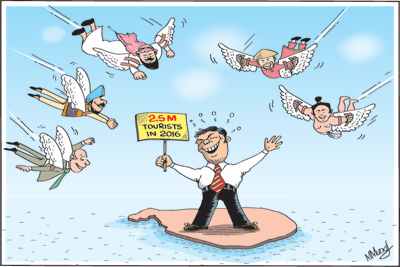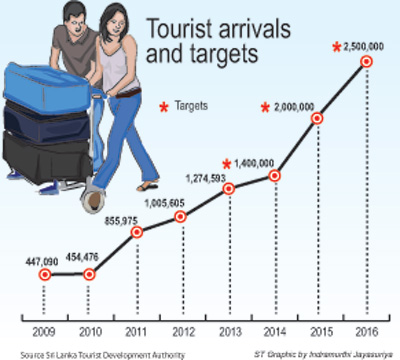Columns
Sustaining the boom in tourism to achieve targets
View(s): Tourism is booming. There has been a progressively increasing trend in tourist arrivals since 2010. The target of 2 million tourists in 2015 and 2.5 million in 2016 is ambitious, but achievable, if conditions remain favourable for travel in the country, prices are competitive and global economic conditions are on an uptrend.
Tourism is booming. There has been a progressively increasing trend in tourist arrivals since 2010. The target of 2 million tourists in 2015 and 2.5 million in 2016 is ambitious, but achievable, if conditions remain favourable for travel in the country, prices are competitive and global economic conditions are on an uptrend.
The surge in tourism is evident from the uptrend in tourist arrivals since 2010. In 2009, the year the war ended, tourist arrivals were a mere 447,090. In 2010 the figure increased only slightly to 454,476. After that there were significant increases. It nearly doubled to 855,875 in 2011. In 2012 a little over 1 million tourists visited the country. The figure increased by 26 per cent in 2013 to record 1.27 million arrivals. This year’s target of 1.4 million tourists would be achieved at year’s end, as over 1 million tourists have arrived before the season begins in November.
 Recent tourist arrivals
Recent tourist arrivals
Although tourists from Western Europe account for a third of arrivals, there have been encouraging new trends in tourist arrivals that ensure stability and growth of tourism. There have been significant increases in tourists from South Asia, the Middle East, East Asia, Eastern Europe and China. The number of South Asian tourists, who account for about 25 per cent of arrivals, increased by 53 per cent.
The number of tourists from China nearly doubled between 2012 and 2013 and a further significant increase is expected this year. The number of visitors from India rose by 55 percent. Indian tourists are finding Sri Lanka attractive owing to the proximity and the value for money due to the exchange rate differential. The frequency of flights also assists in encouraging travel from India. India’s huge middle and upper classes are an enormous potential for increased tourists in the future.
Similarly there is a surge of East Asian visitors whose numbers rose by 66 per cent. There were increases in tourist arrivals from Malaysia and Thailand. The rise of per capita incomes in Asian countries has resulted in expenditure on travel increasing. Sri Lankans too have been travelling abroad more and consequently there has been a higher outflow of funds for travel.
 Economic benefits and linkages
Economic benefits and linkages
The current boom in tourism has led to high expectations of it being a key service input to economic growth and the balance of payments. Tourism makes significant contributions to the economy both directly and indirectly by boosting other economic activities. The backward linkages of tourism are of immense importance to transport services, gem and jewellery trade, arts and crafts, financial services agriculture and food processing. It is estimated that some 270,150 people were employed directly and indirectly in the tourist industry. Earnings from tourism reached US$ 1.75 billion.
The target to attract 2.5 million tourists by 2016 is not an unrealistic goal provided the global economy continues to grow and travel costs do not rise sharply.
There is considerable investment needed to cope with the expected increase in tourists. Quite a large proportion of the existing capacity requires to be refurbished to international standards. This requires substantial investment. Investments have already been made and many hotels, especially in the higher grades have been refurbished. Some hotels that were closed in the Eastern Province have been refurbished and opened to tourists. There is a proliferation of various types of accommodation in many regions of the country.
Complementing foreign tourism has been a spurt in domestic tourism, especially during long weekends and holiday periods. This is a healthy development that adds stability to the industry. There has been a growth of domestic tourism in nearly all parts of the country, especially the North and East and the Southern coast. In response to these there have been a number of guest houses that have been opened. It is very important that domestic tourism is not ignored. Lesser cost comfortable lodging must be provided for the growing number of Sri Lankan travellers in the country.
Investment
The large foreign direct investments in the last couple of years have been in the hospitality trade. Large extents of suitable land have been bought from the state while plans to build five star and even 7 star hotels are afoot. These facilities would take time to complete but would attract tourists in the fullness of time. The large hotel chains that are expected to function in a few years would bring in new and richer tourists. On the other hand, the variety of accommodation that is available caters to different types of tourist needs and affordability.
The euphoria that is gripping the country with respect to tourism must not be ultimately detrimental to the industry, society and the environment. It is important not to overprice our accommodation. Since Sri Lanka is one among a number of tourist destinations and tourists are price sensitive, the pricing of accommodation and food should be competitive. Room rates in Sri Lanka have gone up following an influx of tourists to higher rates than those in Thailand, Indonesia, Vietnam and Kenya. It is important that we do not over price ourselves from this competitive market. The government regulation of charges is an unhealthy development. The hotel industry itself must determine rates and they know best.
There are also many aspects of tourist development that affect the environment adversely. The wildlife parks have had excessive traffic and forest cover has been reduced. It is said that there is a larger gathering of jeeps than the gathering of elephants. There are environmental concerns in Kalpitiya and coastal resorts. In contrast several tourist locations, such as Galle and Nuwara Eliya, have been made more attractive. Preservation of the country’s environment is crucial in sustaining tourism.
There must be continuous vigilance to ensure that there is law and order and that communal or religious violence does not recur. There must be greater efforts to ensure the safety of tourists from harassment by touts and pedlars and pick pockets. These concerns must be addressed in the long term interests of tourism.

